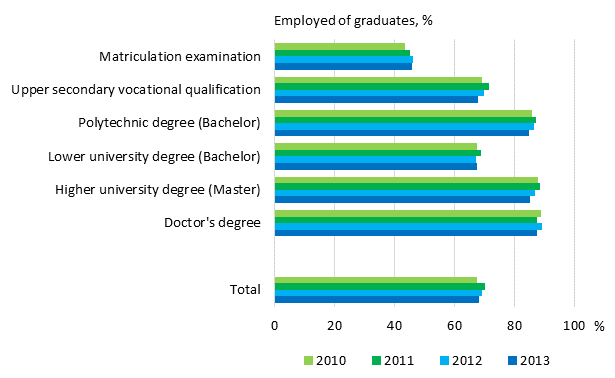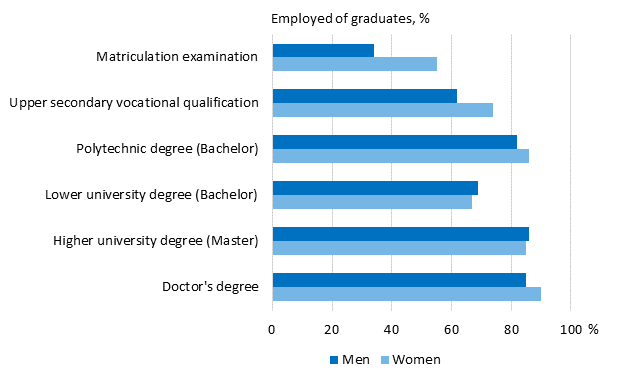Published: 12 February 2015
Employment of recent graduates continued weaking
According to Statistics Finland, employment of recent graduates continued weakening in 2013 as well. Except for those with lower university degrees, the proportion of employed persons was lower in all levels of education than one year previously. Finding a job was easiest for those with doctorate degrees, higher university degrees and polytechnic degrees, of whom around 85 per cent of the graduates were employed.
Employment of graduates on year after graduation by level of education 2010–2013, %

Employment among recent graduates is measured one year after their graduation. Of all recent graduates, 68 per cent were employed, of whom 16 per cent were studying while working. Fourteen per cent of the recent graduates were full-time students. Full-time studying was clearly more common among the passers of the matriculation examination and those with lower university degrees than among those with other qualifications, this was so for 39 per cent of the passers of the matriculation examination and for 30 per cent of those with lower university degrees. More information related to direct transition to further studies of passers of the matriculation examination is available from the statistics on Entrance to education .
The proportion of unemployed persons grew in all levels of education. Of all recent graduates, the proportion of unemployed persons was 11 per cent, which is almost three percentage points more than one year before. At good 17 per cent, the proportion of the unemployed was highest among attainers of upper secondary vocational qualifications. Around eight per cent of the graduates from polytechnics and about seven per cent of the graduates with higher university degrees were unemployed.
Good six out of ten men and three out of four women were employed. The proportion of employed women was ten percentage points higher than that of men. Sixty-two per cent of men with vocation qualifications and 74 per cent of women were working. These shares were 82 per cent for men and 86 per cent for women among those with polytechnic degrees. Men and women with higher university degrees found employment almost equally easily – around 85 per cent of them were working. Compared to the year before, women’s transition to work weakened slightly, by close on two percentage points. The figure for men remained unchanged.
Employment of graduates one year after graduation by sex and level of education 2013, %

There were differences in the transition to working life by field of education. Compared to the year before, employment deteriorated most among graduates from the field of safety and security, down by four percentage points, and from the field of tourism, catering and domestic services, down by three percentage points. The number of unemployed was highest in the fields of technology and transport, and natural resources and the environment, where nearly every fifth recent graduate was without a job. The proportion of unemployed was also high in the fields of culture and tourism, catering and domestic services, around 15 per cent. The transition was easiest for those with qualifications from the field of safety and security, where good nine out of ten were employed, and from the field of social services, health and sport, where almost nine out of ten were employed. In all fields of education, except for the field of social services, health and sport, university degree holders found employment more easily than those with upper secondary qualifications. Among attainers of upper secondary qualifications, unemployment was highest in the fields of technology and transport, and natural resources and culture, good one-fifth of the graduates.
Examined by region, the rate of employment among recent graduates varied from 81 per cent in Åland to 58 per cent in North Karelia. Besides Åland, the rate of employment was higher than the average for the whole country in the regions of Uusimaa, Satakunta, Kanta-Häme, South Ostrobothnia and Ostrobothnia.
Source: Education 2015. Statistics Finland
Inquiries: Anna Loukkola 029 551 3678, Tarja Seppänen 029 551 3220, koulutustilastot@stat.fi
Director in charge: Riitta Harala
Publication in pdf-format (239.3 kB)
- Tables
-
Tables in databases
Pick the data you need into tables, view the data as graphs, or download the data for your use.
Appendix tables
- Figures
Updated 12.2.2015
Official Statistics of Finland (OSF):
Transition from school to further education and work [e-publication].
ISSN=1798-9469. 2013. Helsinki: Statistics Finland [referred: 17.12.2025].
Access method: http://stat.fi/til/sijk/2013/sijk_2013_2015-02-12_tie_001_en.html

